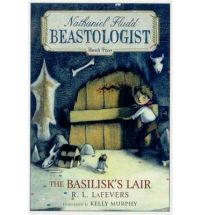
Theodosia Throckmorton, young heroine of R L LaFevers's'Theodosia and the Serpents of Chaos, is proof of the saying that ones work, rather like a gas, will always expand to fill the space given to it. Despite the fact that Theo neither attends school nor is supervised by a governess or tutor, and that her parents, enthralled by the exigencies of their curatorial and archaeological work, are scarcely aware of her existence, Theo in no way lives an idle life. Precocious and bookish, and with an interest in all manner of arcana'an interest rather well served by her daily proximity to the museum in which her father works'Theo spends her days reading up on topics such as ancient Egyptian hexes and curses, an area in which she demonstrates considerable natural talent. While her formal knowledge of the stuff is quite extensive, she also has a bit of an intuitive knack for identifying cursed objects. . .
Such as those brought home by her mother from a recent archaeological dig in Egypt, which sheis horrified to realise are positively crawling with all manner of dark magic. One item in particular results in a near-visceral reaction from sensitive Theo: a legendary amulet known as the Heart of Egypt, which Theo fears is tainted with a curse so foul and powerful that it has the potential to cause the fall of Britain if it ends up in the wrong hands. Which, of course, it does. And, given that the setting of the novel is early 20th Century Britain, the wrong hands, are, of course, Ze Germans. With the help of street urchin pickpocket Sticky Will, her slightly dunderheaded brother Henry, and the slightly wigged-out Lord Wigmere from the Antiquaries Society, Theo sets off after the undeniably evil von Braggenschnott (his name alone, most onomasticians would agree, incites a bit of a tremble in the old knees) in order to retrieve the Heart of Egypt and return it to the tomb where it was found'a task that requires some parental wheedling, a spot of stowing away on a ship bound for Africa, and a rather complex combination of luck and magic.
Given that all of this fits into the space of a mere few hundred (substantially spaced) pages, it's perhaps unsurprising that'Theodosia and the Serpents of Chaos is quite the plot-oriented book. Unfortunately, such breathless rapidity is frequently to the detriment of other essentials such as characterisation and mood, and this sadly serves to undermine the book as a whole. Despite what should be a grimily fascinating and politically fraught setting in pre-WW I London, the authors fails to evoke any real feeling of either location or era, forcing the reader to clutch at occasional snippets about long-skirted dresses, omnibuses, and train station thievery in order to paint a picture of what should be a wonderfully dark and desultory period. The unanchored feel of the book is in part compounded by the depiction of snarky Theodosia, whose speech and attitudes both feel rather too modern for the book's setting.
While many of the characters are little more than sketches, and frequently fail to rise above broadly rendered caricatures, it's Theodosia who to me is the most problematic. The author intends, one imagines, to depict her as witty, gutsy, and ambitious, but her rather galling condescension towards virtually every other character in the novel transforms her instead into something quite unlikeable. Perhaps this is in part because Theodosia tends to act on her own, eschewing cooperation and collaboration unless it serves her ends, or perhaps one could put it down to the astounding neglect of her academically oriented parents, but either way, Id certainly be wary of coming across this young lass in a dark alleyway, or even a well-lit room, for that matter. Given that the novel is written in first person, however, its impossible to escape Theodosia, and one therefore must put up with her unerringly sneering reproaches. Theo does have her moments where pluckiness rather than arrogance shines through, particularly towards the end of the novel, but one has to hope that her facetious tude might be dialled back somewhat in later iterations of the Theodosia series.
The novel also struggles under the weight of some awkward narrative turns that make it difficult for the reader to suspend disbelief. As a reader, Im largely accepting of anything strange and unusualbut only so long as it fits within the logic of the world as set out by the author. Theodosia and the Serpents of Chaos suffers from not a few moments of just because! logic and eyebrow-raising coincidence, particularly in the latter half. Wigmere, for example, tasks Theodosia, who one must recall is an eleven year old girl in pre-womens-lib-era Britain, with personally returning the Heart of Egypt, citing, in what one can only describe as a highly dubious argument, the unavailability of his extensive task for as a recent for doing so. Likewise, a number of narrative coincidences with which I cant help take issue, and which are perhaps the result of editorial pruning, result in awkward montage-esque scenes involving Theo chasing down baddies in labyrinthine London (think the sewer scene in'The Third Man, only without the zither)'and dashing about Cairos market places and Gizas pyramids.
Its a shame that the novel is plagued by such a number of problems, as the Theodosia series otherwise promises a light and entertaining take on Ancient Egyptian mythology and history, and potentially brings with it a strong female narrator whose plight may well be enjoyed not only by female readers, but by that notoriously intransigent and rather difficult to please subsection of the reading populationthe middle years male. However, uninvested and uncritical readers may well enjoy this lively introduction to an archaeological mystery series.
With thanks to Simple Schooling Classroom for the review copy.
This book also appears in our list of'books about Ancient Egyptian mythology
See our review of Theodosia and the Staff of Osiris
Purchase Theodosia and the Serpents of Chaos
Other books by R L LaFevers you might like:














No comments
Follow us on Blog Lovin'